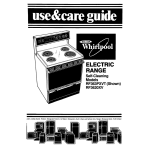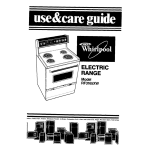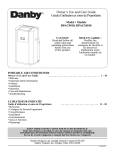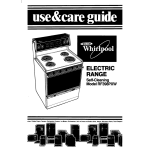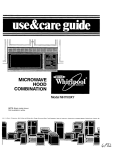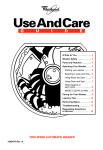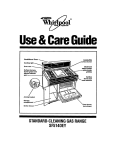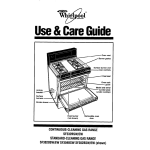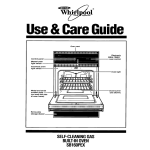Download Whirlpool SF386PEW Specifications
Transcript
Use& CareGuide Manual oven light switch Electronic MEALTIMER control ” oven Oven vent Burner grates Surface burners Automatic oven light switch Anti-tip bracket \ Removable ntarane drawer. Fiberglass (behind right side of storaae drawer) oven (not shown) SELF-CLEANING SEALEDBURNERGASRANGE SF385PEWSF386PEW Contents Page Important Safety Instructions ........................ .3 6 Using Your Range ............................................ Using the surface burners ............................... 6 The electronic oven controls ........................... 7 8 Setting the clock .............................................. Using the electronic Minute Timer.. ................ .8 Using the Oven Off button ............................... 9 9 Using the oven ................................................ 9 Baking .......................................................... 10 Broiling ....................................................... Adjusting the oven temperature control ....... .12 Using the electronic MEALTIMER’” 13 control ........................................................ 15 The oven vent ............................................... 16 The storage drawer ....................................... Caring For Your Range ................................. 17 Control panel and knobs ............................... 17 Surface burner grates ................................... 18 Surface burners and cooktop ........................ 18 Using the Self-Cleaning cycle ....................... 20 24 Cleaning tips ................................................. 25 The oven light ................................................ .............. 26 If You Need Service Or Assistance Whirlpool Cooking Product Warranty .......... 28 01990 Whirlpool Corporation Thank you for buying a Whirlpool appliance. Please complete and mail the Owner Registration Card provided with this product. Then complete the form below. Have this information ready if you need service or call with a question. l Copy model and serial numbers from plate (located as shown) and purchase date from sales slip. l Keep this book, the Cooking Guide and sales slip together in a handy place. Model Number Serial Number Purchase Service Date Company Phone Number You are responsible for: Installing and leveling the range on a floor strong enough to support its weight, and where it is protected from the elements. (See the Installation Instructions.) l Making sure the range is not used by anyone unable to operate it properly. l Properly maintaining the range. l Using the range only for jobs expected of a home range. l Making sure the range is secured by properly installed anti-tip bracket, with rear leveling legs positioned under bracket. l ImportantSafetyInstructions Gas ranges have been thoroughly tested for safe and efficient operation. However, as with any appliance, there are specific installation and safety precautions which must be followed to ensure safe and satisfactory operation. damage l when using the range, follow FOR YOUR SAFETY basic precautions, including l DO NOT STORE OR USE GASOLINE OR OTHER FLAMMABLE VAPORS AND LIQUIDS IN THE VICINITY OF THIS OR ANY OTHER APPLIANCE. THE FUMES CAN CREATE A FIRE HAZARD OR EXPLOSION. l IF 1. 2. 3. 4. FOR YOUR SAFETY l YOU SMELL GAS: OPEN WINDOWS. DON’T TOUCH ELECTRICAL SWITCHES. EXTINGUISH ANY OPEN FLAMES. IMMEDIATELY CALL YOUR GAS SUPPLIER. IMPROPER INSTALLATION, ADJUSTMENT, ALTERATION, SERVICE OR MAINTENANCE CAN CAUSE INJURY OR PROPERTY DAMAGE. REFER TO THIS MANUAL. FOR ASSISTANCE OR ADDITIONAL INFORMATION CONSULT A QUALIFIED INSTALLER, SERVICE AGENCY, MANUFACTURER (DEALER) OR THE GAS SUPPLIER. -IMPORTANTTO THE INSTALLER: PLEASE LEAVE THIS INSTRUCTION BOOK WITH THE UNIT. TO THE CONSUMER: PLEASE READ AND KEEP THIS BOOK FOR FUTURE REFERENCE. 3 Important Safety Instructions Continued Install or locate the range only in accordance with the provided Installation Instructions. It is recommended that the range be installed by a qualified installer. The range must be properly connected to the proper gas supply and checked for leaks. The range must also be properly connected to electrical supply and grounded. l l l l l l l l To reduce the risk of tipping of the appliance, the appliance must be secured by a properly installed anti-tip bracket. To check if the bracket is installed properly, remove the storage drawer (see page 16) and verify that the anti-tip bracket is engaged. Gas fuels and combustion can result in potential exposure to chemicals known to cause cancer or reproductive harm. For example, benzene is a chemical which is a part of the gas supplied to the range. It is consumed in the flame during combustion. However, exposure to a small amount of benzene is possible if a gas leak occurs. Formaldehyde, carbon monoxide and soot are by-products of incomplete combustion. Properly adjusted burners with a bluish rather than a yellow flame will minimize incomplete combustion. Do not operate the range if it is not working properly, or if it has been damaged. Do not use the range for warming or heating the room. Persons could be burned or injured, or a fire could start. Use the range only for its intended use as described in this manual. Do not wear loose or hanging garments when using the range. They could ignite if they touch a hot surface burner and you could be burned. Do not touch surface burners, areas near burners or interior surfaces of oven. Areas near surface burners and interior surfaces of an oven become hot enough to cause burns. During use, do not touch, or let clothing or other flammable materials contact surface burners, areas near surface burners or interior surfaces of oven. Other surfaces of the range may become hot enough to cause burns; such as, the oven vent opening, the surface near the vent opening, the cooktop, the oven door and window. Make sure the utensils you use are large enough to contain food and avoid boil-overs and spill-overs. Heavy splattering or spillovers left on a range can ignite and burn you. Pan size is especially important in deep fat frying. l Turn pan handles inward, but not over other surface burners. This will help reduce the chance of burns, igniting of flammable materials, and spills due to bumping of the pan. l Use only dry potholders. Moist or damp potholders on surface burners may result in burns from steam. Do not let potholder touch surface burners. Do not use a towel or bulky cloth for a potholder. They could catch on fire. . Check to be sure glass cooking utensils are safe for use on the range. Only certain types of glass, glass-ceramic, ceramic, earthenware or other glazed utensils are suitable for ranges without breaking due to the sudden change in temperature. l Do not use decorative covers or trivets over the surface burners. * Do not heat unopened containers. They could explode. The hot contents could cause burns and container particles could cause injury. l Grease is flammable and should be handled carefully. Let fat cool before attempting to handle it. Do not allow grease to collect around cooktop or in vents. Wipe spill-overs immediately. l Do not use water on grease fires. Never pick up a flaming pan. Smother flaming pan on range by covering with a well-fitted lid, cookie sheet or flat tray. Flaming grease outside of pan can be extinguished with baking soda or, if available, a multipurpose dry chemical or foam-type extinguisher. * Never leave surface burners unattended at high heat settings. A boil-over could result and cause smoking and greasy spill-overs that may ignite. l Make sure surface burners are off when you are finished, and when you are not watching. l Use care when opening oven door. Let hot air or steam escape before removing or replacing food. l Always position oven racks in desired location while oven is cool. l Do not store flammable materials on or near the range. They could explode or burn. l Do not store things children might want above the range. Children could be burned or injured while climbing on it. l l l l l l l l Do not leave children alone or unattended in area where the range is in use. They should never be allowed to sit or stand on any pat-t of the range. They could be burned or injured. Never use a match or other flame to look for a gas leak. Explosion and injury could result. Know where your main gas shut off valve is located. Keep range vents unobstructed. Clean your range regularly. See care and cleaning instructions in this manual. Be sure all range parts are cool before cleaning. Do not clean door seal. It is essential for a good seal. Care should be taken not to rub, damage, or move the seal. Clean only parts recommended in this Use and Care Guide. -SAVE l l l l Do not use oven cleaners. No commercial oven cleaner or oven liner protective coating of any kind should be used in or around any part of the oven. Before self-cleaning the oven, remove broiler pan, broiler grid, oven racks and other utensils. Do not use your oven to clean miscellaneous parts. Do not repair or replace any part of the range unless specifically recommended in this manual. All other servicing should be referred to a qualified technician. Disconnect the electrical supply before servicing the range. THESE INSTRUCTIONS- UsingYourRange Surface burner maker / i i’ I Using the surface burners Control knobs must be pushed in, then turned to the LITE position. The clicking sound is the ignition sparking. To stop the clicking sound after the burner lights, turn the control knob back to a desired setting. The control knob has stops for HI, medium and low, however, it can be set anywhere between LOW and OFF. Surface burner markers The solid dot in the surface burner marker shows which surface burner is turned on by that knob. Until you get used to the settings, use the following as a guide. For best results, start cooking at the high settings; then turn the control knob down to continue cooking. NOTE: All settings are marked on the sides of the control knobs. Use LITE to light the burner. After the burner lights, turn control to a desired setting to stop the clicking of the ignition. Use HI to start foods cooking: to bring liquids to a boil. Use a medium setting to continue cooking or to fry chicken or pancakes; for gravy, puddings and icing; to cook large amounts of vegetables. Use a low setting to keep food warm until ready to serve. NOTE: Do not cook with the control in the LITE position. In case of a prolonged power failure Surface burners can be manually lighted. Hold a lighted match near a burner and turn the control to the LITE position. After the burner lights, turn the control to the desired setting. Burn, Fire and Explosion Hazard Burner flame should not extend beyond the edge of the cooking utensil. The flame can burn you and cause poor cooking results. l Be sure all control knobs are turned to OFF when you are not cooking. Someone could be burned or a fire could stat-l if a burner is accidentally left ON. ) If the flame should go out while cooking, or if there is a strong gas odor, turn the burners OFF. Wait five minutes for the gas odor to disappear, before relighting burner. If gas odor is still present, see safety note on page 3. Failure to follow these precautions could result in explosion or fire. ) Do not attempt to light the oven burner during a power failure. Personal injury could result. l 6 The electronic oven controls There are three parts in the oven control section: -The digital display. -The command buttons. -The Set Knob. Instructions for each oven control are covered on the following pages. Read them carefully. When you first plug in the range, the time display will flash until you set a new time. If, after you set the clock (page 8) the time display flashes, your electricity was off for a while. Reset the clock. Digital display/clock When you are not using the oven, this is an accurate digital clock. When using the oven or Minute Timer, the display will show the time, temperature settings and what command buttons have been pressed. When showing the time of day, the display will show the hour and minutes. When using the Minute Timer, the display shows minutes and seconds in the following sequence: For settings from 0 minutes to 1 minute 55 seconds, the display will increase in 5second increments. For settings from 2 minutes to 9 minutes 50 seconds, the display will increase in 1O-second increments. For settings from 1O-59 minutes, the display will increase in 1-minute increments. For settings from 1 hour to 1 hour 55 minutes, the display will increase in 5-minute increments. For settings from 2 hours to 9 hours 50 minutes, the display will increase in 1O-minute increments. When using Bake Time, the display shows hour and minutes. Command buttons The command buttons tell the oven what to do and in what order. A few examples: -Time Of Day tells the oven you are going to set the clock. -Oven Off tells the oven to turn off. Each command button (except Oven Off) has its own indicator. The indicator comes on when you touch the command buttons. Set Knob Once you’ve pushed a command button to tell the oven what you want it to do, you’ll use the Set Knob to set a temperature or time. Turning the Set Knob clockwise increases the number on the display. Turning the Set Knob counterclockwise decreases the number on the display. Using Your Range Contmued Setting the clock 1. Push the Time of Day button. The TIME indicator will show in the display. Release the Time of Day button. 2. Turn the Set Knob until the correct time shows in the large display. Using the electronic Minute Timer The Minute Timer does not start or stop the oven. It works like a kitchen timer. It can be set in minutes and seconds up to 9 hours, 50 minutes. You will hear three beeps when the set time is up, then one beep every IO seconds for 5 minutes or until the Min/Sec Timer button is pushed. 1. Push the Min/Sec Timer button. The TIMER indicator will come on and the large display will show “:OO.” 2. Turn the Set Knob until the desired time shows in the large display. The Minute Timer will begin counting down 2 seconds after the time is set. When time is up, you will hear three beeps. To cancel the Minute Timer: Push the MiniSec Timer button. a Using the Oven Off button The Oven Off button will except for times set with button. The large display of day or, if Minute Timer time remaining. cancel any command the MiniSec Timer will then show the time is also being used, the Using the oven Baking Position the rack(s) properly before turning on the oven. To change rack position, pull rack out to stop, raise front edge and lift out. The rack(s) should be placed so the top of the food will be centered in the oven. Always leave at least 1 112 to 2 inches (4-5 cm) between the sides of the pan and the oven walls and other pans. For more information, see the Cooking Guide. Push the Bake Temp button. “---“’ will show in the small display and the BAKE indicator will come on. NOTE: Make sure the door is unlocked. If the door is locked, the oven will not bake. To set a baking temperature, turn the Set Knob until the desired temperature shows in the small display. The display will increase in 5°F increments. The BAKE and ON indicators will come on. The burner will light in 50-60 seconds. Put food in the oven. During baking, the oven burner will turn on and off to keep the oven temperature at the setting. The ON indicator will cycle on and off with the burner. 5. When baking is done, push the Oven Off button. The oven will then shut off. 9 Using Your Range Contmued Broiling 1. Position the rack before turning the oven on. Refer to the chart on page 11 for recommended rack positions. 2. Preheat in BROIL for 5 minutes with oven door closed. Do not preheat with broiler pan in place. 3. To preheat, push the Broil button. “---” will show in the small display and the BROIL indicator will come on. NOTE: Make sure the door is unlocked. If the door is locked, the oven will not broil. 4. You can preheat at one of two settings - “LO” or “HI.” Turn the Set Knob to the setting you want. When the oven turns on, the ON indicator will come on. The burner lights automatically in 50-60 seconds. Preheat for 5 minutes. NOTE: For most foods, broil at “HI.” The “LO” setting can be used when broiling foods which overcook easily, such as fish or meringues. The “LO” setting can also be used when broiling foods that are precooked. 5. After preheating, put the broiler pan and food on the rack. 6. Completely close the oven door to assure proper broiling temperatures. 7. When broiling is done, push the Oven Off button. The time of day will then show in the large display. 10 Broiling tips Use the broiler pan and grid for broiling. They are designed to drain excess liquid and fat away from the cooking surface to help prevent spatter, smoke or fire. l If you broil small quantities, you may want to use a small broiler pan. They are available in the housewares section of many department stores. l For best broiling results, preheat in BROIL for 5 minutes. Do not preheat with broiler pan in place. . Rack position determines how infra-red rays cook your food. The lower the position, the more broiler grid area covered by the rays. See “Rack position chat-t” below for more information. l To sear meat, place broiler pan at one of the higher rack positions so that meat is very near the flame. l Small steaks, hamburger patties, etc., may be broiled in the higher rack positions. l To cook large steaks and other thick cuts of meat well done, move them to a lower rack position after searing. l Refer to a broiling chart in a reliable cookbook for correct broiling times. l After broiling, remove the broiler pan from the oven when you remove the food. Drippings will bake on the pan if it is left in the heated oven. l l l Fire Hazard Place meat the correct distance from the burner. Meat placed too close to the burner may spatter, smoke, burn or catch fire during broiling. To ensure adequate grease drainage, do not use cookie sheets or similar pans for broiling. Also, covering the broiler grid with foil is not recommended. Poor drainage of grease may result in fire. Rack position chart RACK POSITION FROM BOTTOM 5 Medium steaks and fish Well-done foods such as chicken, lobster, ham slices Using Your Range Continued Adjusting the oven temperature control Does your oven seem hotter or colder than your old oven? The temperature of your old oven may have shifted gradually without you noticing the change. Your new oven is properly adjusted to provide accurate temperatures. But, when compared to your old oven, the new design may give you different results. If, after using the oven for a period of time, you are not satisfied with the temperature settings, they can be adjusted by following these steps: 1. Push the Bake Temp button. 2. Turn the Set Knob until 550°F appears on the small display. 3. Within two seconds, push and hold the Bake Temp button until the special two-digit display appears. Release the Bake Temp button. The display now indicates the amount of degrees offset between the original factory temperature setting and the current temperature setting. If the oven control has the original factory setting, the display will read “00.” 4. You can now change the setting up or down 35”F, in 5°F steps. To do so, turn the Set Knob until the desired amount of offset appears in the display. NOTE: If you have decreased the setting, a minus sign (-) will appear before the number. 5. When you have made the desired adjustment, push the Oven Off button to go back to the time of day display. NOTE: Adjusting the oven temperature control will only change cooking temperatures. It will not affect self-cleaning temperatures. 12 Using the electronic MEALTIMER’“’control The electronic MEALTIMER control is designed to turn the oven on and off at times you set, even when you are not around. Automatic baking is ideal for foods which do not require a preheated oven such as meats and casseroles. Do not use the automatic cycle for cakes, cookies, etc...undercooking will result. To start baking now and stop automatically: 1. Position rack(s) properly, and place the food in the oven. 2. Push the Bake Time button. “--:--‘I will show in the large display and the BAKE and TIME indicators will come on. 3. Turn the Set Knob clockwise until the desired baking time, up to 11 hours 50 minutes, shows in the large display. 4. Push the Bake Temp button and set the desired temperature. The display will show the set temperature and the time remaining. The TIME, BAKE and ON indicators will come on. The display will count down in 1-minute increments. When baking time is completed, the oven will turn off automatically, beep 3 times, then beep once every 10 seconds for 5 minutes or until the Oven Off button is pushed. The time of day will show in the large display. 5. 6. 13 Using Your Range Contmued To delay start and stop automatically: 1. Position the oven rack(s) properly, and place the food in the oven. 2. Push the Bake Time button. “--:--” will show in the large display and the BAKE and TIME indicators will come on. 3. Turn the Set Knob clockwise until the desired baking time shows in the display. Push the Stop Time button. The BAKE, STOP and TIME indicators will come on. Turn the Set Knob clockwise until the desired stop time shows in the large display. The DELAY, BAKE, STOP and TIME indicators will come on. The oven will beep once every 10 seconds until a baking temperature is selected. Push the Bake Temp button and set the desired temperature. The BAKE indicator will come on. Changes can be made at any time by pressing a command button. When the start time is reached, the DELAY and STOP indicators will go off. The display will show the oven temperature and the ON indicator will come on. When baking time is completed, the oven will turn off automatically, beep 3 times, then beep once every 10 seconds for 5 minutes or until the Oven Off button is pushed. The time of day will show in the large display. 14 To cancel the MEALTIMER’ control setting: Push the Oven Off button. The time of day will then show in the large display. To avoid sickness and food waste when using the MEALTIMER II control: . Do not use foods that will spoil while waiting for cooking to start, such as dishes with milk or eggs, cream soups, and cooked meats or fish. Any food that has to wait for cooking to start should be very cold or frozen before it is put in the oven. MOST UNFROZEN FOODS SHOULD NEVER STAND MORE THAN TWO HOURS BEFORE COOKING STARTS. l Do not use foods containing baking powder or yeast when using delay start. They will not rise properly. l Do not allow food to remain in oven for more than two hours after end of cooking cycle. The oven vent Oven vent Hot air and moisture escape from the oven through a vent just under the backguard. The vent is needed for air circulation. Do not block the vent. Poor baking will result. . Burn Hazard When the oven is ON, pans and pan handles left near the oven vent can become hot enough to burn the user and to melt plastics. Use potholders to move pans. Never store plastics, paper or other items that could melt or burn near the oven vent, or any of the surface burners. Using Your Range Continued The storage drawer The storage drawer is for storing pots and pans. The drawer can be removed to make it easier to clean under the range, and to check for installation of the anti-tip bracket. Use care when handling the drawer. Removing the storage drawer: 1. Empty drawer of any pots and pans before removing drawer. 2. Pull drawer out slightly. Lift front and pull all the way out. Replacing the storage drawer: 1. Fit ends of drawer slide rails into the oven slide rails on both sides of opening. 2. Lift front and slide drawer closed. Drawer’slide rail w To verify that the anti-tip bracket is engaged: l Remove storage drawer. l Look to see if the anti-tip bracket is attached to floor with screws. l Make sure rear leveling legs are positioned under bracket. . See “Important Safety Instructions” on page 4 and Installation Instructions for further details. NOTE: The range will not tip during normal use. Tipping can occur if excessive force or weight is applied to open door without anti-tip bracket properly secured. 16 CaringForYourRange Burn, Electrical Shock, Fire and Explosion Hazard . Make sure all controls are OFF and the range is cool before cleaning. 9 Do not use oven cleaners, bleach or rust removers. l Do not use gasoline or other flammable liquids or vapors to clean this or any other appliance. l Keep the appliance area clear and free from combustible materials, gasoline and other flammable vapors and liquids. l Do not obstruct the flow of combustion and ventilation air. Failure to follow these guidelines could result in burns, electrical shock, fire or explosion. Control panel and knobs 1. Turn control knobs to the OFF position. 2. Pull control knobs and command buttons straight off. 3. Use warm, soapy water or spray glass cleaner and a soft cloth to wipe the control panels. Rinse and wipe dry with a soft cloth. 4. Wash control knobs and command buttons in warm, soapy water. Rinse well and dry with a soft cloth. Do not soak. 17 Caring For Your Range Continued 5. Replace control knobs and command buttons by pushing them firmly into place. NOTE: When cleaning, never use steel wool, abrasives, or commercial oven cleaners which may damage the finish. After cleaning, make sure all control knobs point to the OFF position. Make sure you have not turned oven ON when replacing buttons. If oven has been turned on, push Oven Off button. Surface burner grates 1. Make sure all surface burners are off and the surrounding parts are cool. 2. Lift off the burner grates. 3. Wash the grates with warm, soapy water. Use a non-abrasive plastic scouring pad for heavily-soiled areas. Rinse and dry well. Do not place grates in Self-Cleaning Oven. 4. Replace burner grates. Surface burners and cooktop 18 The cooktop and burner box areas are specially designed to make cleaning easier. Since the four burners are sealed, cleanups are easy and convenient. To clean the cooktop, wipe with a damp cloth and dry. lgnitor Contoured well area Cleaning Cleaning Burner cap Typical surface burner the contoured well areas The contoured well is a recessed area located around each burner. If spills occur in the contoured well section, blot up spill with an absorbent cloth. Rinse with a clean damp cloth and dry. When cleaning the cooktop area or around the burner base, use care to prevent damage to the ignitor. If a cleaning cloth should catch the metal ignitor electrode, it could damage or break the electrode. If the electrode is damaged or broken, the surface burner will not light. When cleaning the cooktop, leave the burner cap in place to protect the electrode from possible damage. the burners The burner caps should be routinely removed and cleaned. Always clean the burner caps after a spill-over. Keeping the burner caps clean will prevent improper ignition and an uneven flame. To clean, pull the burner cap straight up from the burner base. Remove the trim ring. (Trim ring must be replaced over burner base before replacing burner cap. Do not operate burners without trim rings in place.) Clean burner cap and trim ring with warm, soapy water and a soft cloth. You can also clean with a non-abrasive scrubbing pad or cleanser. Do not clean burner cap or trim ring in dishwasher or Self-Cleaning Oven. For proper flow of gas and ignition of the burner, DO NOT ALLOW SPILLS, FOOD, CLEANING AGENTS OR ANY OTHER MATERIAL TO ENTER THE GAS TUBE OPENING. If the opening or the orifice, located inside the opening, becomes soiled or clogged, use a cotton swab or a soft cloth to clean the area. Gas must flow freely through the small hole in the brass orifice for the burner to light properly. This area must be free of any soil and be kept protected from boil-overs or spill-overs. ALWAYS keep the burner caps in place whenever a surface burner is in use. After cleaning the gas tube opening, replace the burner cap and trim ring. Occasionally check the burner flames for proper size and shape as shown. If flames lift off ports, are yellow, or are noisy when turned off, you may need to clean the burners. If ports are clogged, clean with a straight pin. Do not enlarge or distort port. Do not use a wooden toothpick. If adjustment is needed, call a qualified technician for service. flame Locating tab To replace burner cap, make sure cap is properly aligned and leveled. Find the recessed locating tab on the burner cap (see illustration) and place cap over the white ignitor in the burner base. Turn the burner on to determine if it will light. If the burner does not light after cleaning, contact an authorized WhlrlpoolsM service technician. Do not service the sealed burner yourself. 19 Caring For Your Range Continued Using the Self-Cleaning cycle The Self-Cleaning cycle uses very high heat to burn away soil. Before you start, make sure you understand exactly how to use the Self-Cleaning cycle safely. Hand clean frame Hand clean door around edge ’ i Do not hand clean seal 20 Before you star! I. Clean the areas shown by hand. They do not get hot enough during ihe Self-Cleaning cycle for soil to burn away. Use hot water and detergent or a soapy steel wool pad on... l The inside of the door. (The center area of the door does not need to be hand cleaned.) l The frame around the oven. Do not clean, move or bend the fiberglass seal. Poor cleaning and poor baking will result. 2. Remove the broiler pan and any pots and pans you may have stored in the oven. NOTE: The broiler pan and grid can be cleaned in the oven only if most of the soil has been removed by hand-cleaning or a dishwasher. 3. Wipe out any loose soil or grease. This will help reduce smoke during the Self-Cleaning cycle. 4. If you want the oven racks to remain shiny, remove from the oven and clean them by hand. Otherwise, put oven racks on second and fourth guides (guides are counted from bottom to top). After racks are cleaned in the Self-Cleaning cycle, they become harder to slide. See page 24. Heat and odors are normal during the cycle. If needed, remove them by opening a window or by turning on a vent hood or other kitchen vent during the Self-Cleaning cycle. Personal Injury and Product Damage Hazard mDo not touch the oven during the SelfCleaning cycle. It could burn you. mDo not use commercial oven cleaners in your oven. Cleaners may produce hazardous fumes or damage the porcelain finish. . Do not force the Lock Lever. You could bend or break it. The lever is designed to stay locked until the oven is cool enough to safely open. Wait until it moves freely. l Do not use foil or other liners in the oven. During the Self-Cleaning cycle foil can burn or melt and damage the oven surface. l Do not block the vent during the SelfCleaning cycle. Air must move freely for best cleaning results. l Do not leave plastic utensils near the vent. They may melt. Setting the controls 1. Make sure the Clock is set to the right time of day. (See “Setting the clock” on page 8.) 2. Move the Lock Lever all the way to the rightthe Clean position. 3. Push the Self Clean button. 4. Turn the Set Knob until “3:OO” and the CLN and TIME indicators appear on the display. Three hours is recommended for moderatelysoiled ovens. A Self-Cleaning cycle can be set for a 2-4 hour period. The CLEAN and ON indicators will come on to indicate that cleaning has begun. NOTE: If the Self Clean button is pushed when the door is not latched, “door” will appear in the large display. Move the Lock Lever all the way to the right to latch the door. 21 Caring For Your Range Continued 5. (Option) Delayed clean: After setting the cleaning time, immediately push the Stop Time button. Immediately turn the Set Knob to the new stop time. The DELAY, CLN, STOP and TIME indicators will come on. 6. After the Self-Cleaning cycle is started, the LOCKED indicator will come on when the oven temperature exceeds normal baking temperatures. The Lock Lever must not be moved and the door cannot be opened when this indicator is on. 7. After the Self-Cleaning cycle is completed, the CLEAN indicator will go off and the time of day will show in the large display. 8. When the oven reaches normal baking temperatures, the LOCKED indicator goes off. Move the Lock Lever back to the left. Do not force it. Wait until it moves easily. 9. After the oven is cool, wipe off any residue or ash with a damp cloth. If needed, touch up spots with a soapy steel wool pad. Special tips Keep the kitchen well-ventilated during the SelfCleaning cycle to help get rid of heat, odors and smoke. l Clean the oven before it gets heavily soiled. Cleaning a very soiled oven takes longer and results in more smoke than usual. l If the Self-Cleaning cycle doesn’t get the oven as clean as you expected, the cycle may not have been set long enough or you may not have prepared the oven properly. Set the SelfCleaning cycle longer the next time and hand clean areas noted on page 20. l To stop the Self-Cleaning cycle at any time: 1. Push the Oven Off button. 2. When the LOCKED indicator goes off, move the Lock Lever back to the left. Do not force it. Wait until it moves easily. 22 How it works During the Self-Cleaning cycle, the oven gets much hotter than it does for baking or broiling...approximately 875°F (468°C). This heat breaks up grease and soil and burns it off. This graph shows approximate temperatures and times during a Self-Cleaning cycle for three hours. Self-Cleaning (Approximate cycle - three hour setting temperatures and times) 1000°F 538°C 800°F 427°C 600°F 316°C 400°F OR AT 550°F (288°C) OR AT 550°F (288°C) \ 200°F -----START 204°C 93°C 112hr. 1 hr. 1 112hrs. 2 hrs. 2 112hrs. 3 hrs. 3 i/2 hrs. STOP Notice that the heating stops when the 3 hour setting is up, but that it takes longer for the oven to cool down enough to unlock. Caring For Your Range Continued Cleaning tips Control knobs Clean with warm, soapy water and a soft cloth. l Wash, rinse and dry well. l Do not soak. Control panels Clean with warm, soapy water or spray glass cleaner and a soft cloth. l Wash, rinse and dry well. l Follow directions provided with the cleaner. Exterior surfaces (other than control panel) Clean with warm, soapy water and a soft cloth. l Wipe off regularly when cooktop and oven are cool. Use a non-abrasive plastic scrubbing pad for heavily-soiled areas. . Do not use abrasive or harsh cleaners. NOTE: Do not allow food containing acids (such as vinegar, tomato or lemon juice) to remain on surface. Acids may remove the glossy finish. Also, wipe up milk or egg spills when cooktop is cool. Be careful when cleaning around model and serial number plate; the numbers wipe off easily. Surface burners, grates, caps and trim rings See pages 18 and 19 for cleaning instructions. Broiler pan and grid Clean with warm, soapy water or a soapy steel wool pad. 9 Clean after each use. l Wash, rinse and dry well. l Do not clean in Self-Cleaning Oven. (See note on page 20.) 24 Oven racks Use Self-Cleaning cycle. . Leave in oven during Self-Cleaning cycle. OR Clean with warm, soapy water or soapy steel wool pads. l Wash, rinse and dry. Use soapy steel wool pads for heavily-soiled areas. NOTE: The oven racks will discolor and be harder to slide when left in the oven during the Self-Cleaning cycle. If you want them to stay shiny, remove from the oven and clean by hand. If racks are left in the oven during the SelfCleaning cycle, apply a small amount of vegetable oil to the sides of the racks to make them easier to slide. Oven door glass Use spray glass cleaner or warm, soapy water and a non-abrasive plastic scrubbing pad. l Make sure oven is cool. l Follow directions provided with the cleaner. l Wash, rinse and dry well. Self-Cleaning oven For areas outside the Self-Cleaning area use warm, soapy water or soapy steel wool pads. l Follow directions starting on page 20, “Using the Self-Cleaning cycle.” l Do not use commercial oven cleaners. l Do not use foil to line the bottom of your SelfCleaning Oven. The oven light The Oven Light will come on when you open the oven door. To turn the light on when the oven door is closed, push the Oven Light Switch on top of the backguard. Push the switch again to turn off the light. Electrical l l Shock and Personal Injury Hazard Make sure oven and light bulb are cool and power to the oven has been turned off before replacing the light bulb. Failure to do so could result in electrical shock or burns. The bulb cover must be in place when using the oven. The cover protects the bulb from breaking, and from high oven temperatures. Since bulb cover is made of glass, be careful not to drop it. Broken glass could cause injury. To replace the oven light: 1. Unplug appliance or disconnect at the main power supply. 2. Remove the glass bulb cover in the back of the oven by pulling out and pushing the wire holder to the side. 3. Remove the light bulb from ifs socket. Replace with a 40-watt appliance bulb. 4. Replace the bulb cover and snap the wire holder in place. Plug in appliance or reconnect at the main power supply. NOTE: Make sure oven light is off during the Self-Cleaning cycle. Keeping oven light on will shorten bulb life. 25 If YouNeedServiceOrAssistance.. . We suggest you follow these steps: 1. Before calling for assistance... Performance problems often result from little things you can find and fix without tools of any kind. If nothing operates: l Is the gas turned on? l Is the power supply cord plugged into a live circuit with the proper voltage? (See Installation Instructions.) . Have you checked your home’s main fuses or circuit breaker box? l Have instructions in this book been followed? l Is the control knob set in the correct position? . Is the flow of combustion and/or ventilation air to the unit obstructed? Do not obstruct air flow to and around unit. l Recheck suspected defect. If the oven will not operate: l Are the electronic controls set correctly? See pages 7-l 5. l Have you programmed a delay start time? If burner fails to light: l Is the range connected to electrical power? l Have you checked your home’s main fuses or circuit breaker box? l Are burner ports clogged? See page 19. If burner flames are uneven: l Are burner ports clogged? See page 19 If burner flames lift off ports, are yellow, or are noisy when turned off: l The air/gas mixture may be incorrect. (Call for service.) If burner makes a popping noise when ON: l Is the burner wet from washing? Let dry. If control knob(s) will not turn: l Did you push in before trying to turn? If the Self-Cleaning cycle will not operate: 9 Does the clock show the right time of day? l Is the Lock Lever all the way to the right? l Have you set a delay start time? 26 If cooking results are not what you expected: l Is the range level? l Does the oven temperature seem too low or too high? See page 12. l If needed, have you preheated the oven as the recipe calls for? . Does the flame size fit the cooking utensil being used? (See the Cooking Guide.) l If broiling, have you completely closed the oven door? Broiler provides best cooking results with the oven door closed. . Are you following a tested recipe from a reliable source? l Are you using pans recommended in the Cooking Guide? l If baking, have you allowed 1 i/2 to 2 inches (4-5 cm) on all sides of the pans for air circulation? l Are the pans the size called for in the recipe? 9 Do the cooking utensils have smooth, flat bottoms and fit the surface burners being used? See the Cooking Guide for more information on cooking problems and how to solve them. 2. If you need assistance*... Call Whirlpool COOL-LINE” service assistance telephone number. Dial free from anywhere in the U.S.: 1-800-253-l 301 and talk with one of our trained consultants. The consultant can instruct you in how to obtain satisfactory operation from your appliance or, if service is necessary, recommend a qualified service company in your area. If you prefer, write to: Mr. Donald Skinner Director of Consumer Relations Whirlpool Corporation 2000 M-63 Benton Harbor, Ml 49022 Please include a daytime phone number in your correspondence. 3. If you need service*... Whirlpool has a nationwide network of authorized WhirlpoolSM service companies. Whirlpool service technicians are trained to fulfill the product warranty and provide after-warranty service, anywhere in the United States. To locate the authorized Whirlpool service company in your area, call our COOL-LINE! service assistance telephone number (see Step 2) or look in your telephone directory Yellow Pages under: APPLIANCES - HOUSEHOLD MAJOR-SERVICE B REPAIR ELECTRICAL APPLIANCES MAJOR-REPAIRING & PARTS 5. If you are not satisfied problem was solved*... with how the Contact the Major Appliance Consumer Action Panel (MACAP). MACAP is a group of independent consumer experts that voices consumer views at the highest levels of the major appliance industry. Contact MACAP only when the dealer, authorized servicer or Whirlpool have failed to resolve your problem. Major Appliance Consumer Action Panel 20 North Wacker Drive Chicago, IL 60606 MACAP will in turn inform us of your action. OR WASHING MACHINES, DRYERS 8 IRONERS - SERVICING WHIRLPOOLAPPLIANCES AUTHORIZEDWHIRLPOOLSERVICE SERVICE COMPANIES XYZSERVICECO 123 Maple 999.9999 ‘When requesting assistance, please provide: model number, serial number, date of purchase, and a complete description of the problem. This information is needed in order to better respond to your request. 4. If you need FSP replacement parts*... FSP is a registered trademark of Whirlpool Corporation for quality parts. Look for this symbol of quality whenever you need a replacement part for your Whirlpool appliance. FSP replacement parts will fit right and work right, because they are made to the same exacting specifications used to build every new Whirlpool appliance. To locate FSP replacement parts in your area, refer to Step 3 above or call the Whirlpool COOL-LINE service assistance number in Step 2. 27 WHIRLPOOL” GasCookingProductWarranty GR002 LENGTH OF WARRANTY WHIRLPOOL FULL ONE-YEAR WARRANTY From Date of Purchase FSP” replacement parts and repair labor to correct defects in materials or workmanship. Service must be provided by an authorized WhirlpoolSM service company. WILL PAY FOR I WHIRLPOOL WILL NOT PAY FOR A. Service calls to: 1. Correct the installation of the cooking product, 2. Instruct you how to use the cooking product. 3. Replace house fuses or correct house wiring or plumbing. 4. Replace owner accessible light bulbs. B. Repairs when the cooking product is used in other than normal, single-family household use. C. Pick-up and delivery. This product is designed to be repaired in the home. D. Damage to the cooking product caused by accident, misuse, fire, flood, acts of God or use of products not approved by Whirlpool. WHIRLPOOL CORPORATION SHALL NOT BE LIABLE FOR INCIDENTAL OR CONSEQUENTIAL DAMAGES. Some states do not allow the exclusion or limitation of incidental or consequential damages so this limitation or exclusion may not apply to you. This warranty gives you specific legal rights, and you may also have other rights which vary from state to state. Outside the United States, a different warranty may apply. For details, please contact your authorized Whirlpool distributor or military exchange. If you need service, first see the “Service and Assistance” section of this book. After checking “Service and Assistance,” additional help can be found by calling our COOL-LINE” service assistance telephone number, l-800-253-1301, from anywhere in the U.S. 8 Registered Trademark Part No. 56001180077/816515 01990 Whirlpool Corporation / TM Trademark / SM Service Mark of Whirlpool Corporation Printed in U.S.A.




























